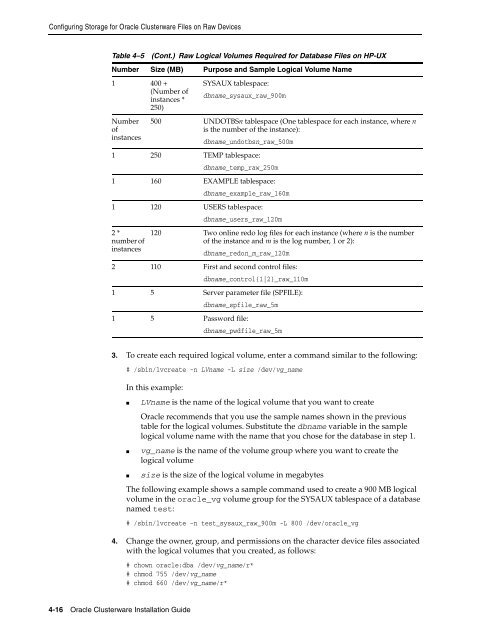Oracle Database Oracle Clusterware Installation Guide for HP-UX
Oracle Database Oracle Clusterware Installation Guide for HP-UX
Oracle Database Oracle Clusterware Installation Guide for HP-UX
You also want an ePaper? Increase the reach of your titles
YUMPU automatically turns print PDFs into web optimized ePapers that Google loves.
Configuring Storage <strong>for</strong> <strong>Oracle</strong> <strong>Clusterware</strong> Files on Raw Devices<br />
Table 4–5 (Cont.) Raw Logical Volumes Required <strong>for</strong> <strong>Database</strong> Files on <strong>HP</strong>-<strong>UX</strong><br />
Number Size (MB) Purpose and Sample Logical Volume Name<br />
1 400 +<br />
(Number of<br />
instances *<br />
250)<br />
Number<br />
of<br />
instances<br />
3. To create each required logical volume, enter a command similar to the following:<br />
4-16 <strong>Oracle</strong> <strong>Clusterware</strong> <strong>Installation</strong> <strong>Guide</strong><br />
# /sbin/lvcreate -n LVname -L size /dev/vg_name<br />
In this example:<br />
SYSA<strong>UX</strong> tablespace:<br />
dbname_sysaux_raw_900m<br />
500 UNDOTBSn tablespace (One tablespace <strong>for</strong> each instance, where n<br />
is the number of the instance):<br />
dbname_undotbsn_raw_500m<br />
1 250 TEMP tablespace:<br />
dbname_temp_raw_250m<br />
1 160 EXAMPLE tablespace:<br />
dbname_example_raw_160m<br />
1 120 USERS tablespace:<br />
2 *<br />
number of<br />
instances<br />
dbname_users_raw_120m<br />
120 Two online redo log files <strong>for</strong> each instance (where n is the number<br />
of the instance and m is the log number, 1 or 2):<br />
dbname_redon_m_raw_120m<br />
2 110 First and second control files:<br />
■ LVname is the name of the logical volume that you want to create<br />
<strong>Oracle</strong> recommends that you use the sample names shown in the previous<br />
table <strong>for</strong> the logical volumes. Substitute the dbname variable in the sample<br />
logical volume name with the name that you chose <strong>for</strong> the database in step 1.<br />
■ vg_name is the name of the volume group where you want to create the<br />
logical volume<br />
■ size is the size of the logical volume in megabytes<br />
The following example shows a sample command used to create a 900 MB logical<br />
volume in the oracle_vg volume group <strong>for</strong> the SYSA<strong>UX</strong> tablespace of a database<br />
named test:<br />
# /sbin/lvcreate -n test_sysaux_raw_900m -L 800 /dev/oracle_vg<br />
4. Change the owner, group, and permissions on the character device files associated<br />
with the logical volumes that you created, as follows:<br />
# chown oracle:dba /dev/vg_name/r*<br />
# chmod 755 /dev/vg_name<br />
# chmod 660 /dev/vg_name/r*<br />
dbname_control{1|2}_raw_110m<br />
1 5 Server parameter file (SPFILE):<br />
dbname_spfile_raw_5m<br />
1 5 Password file:<br />
dbname_pwdfile_raw_5m
















